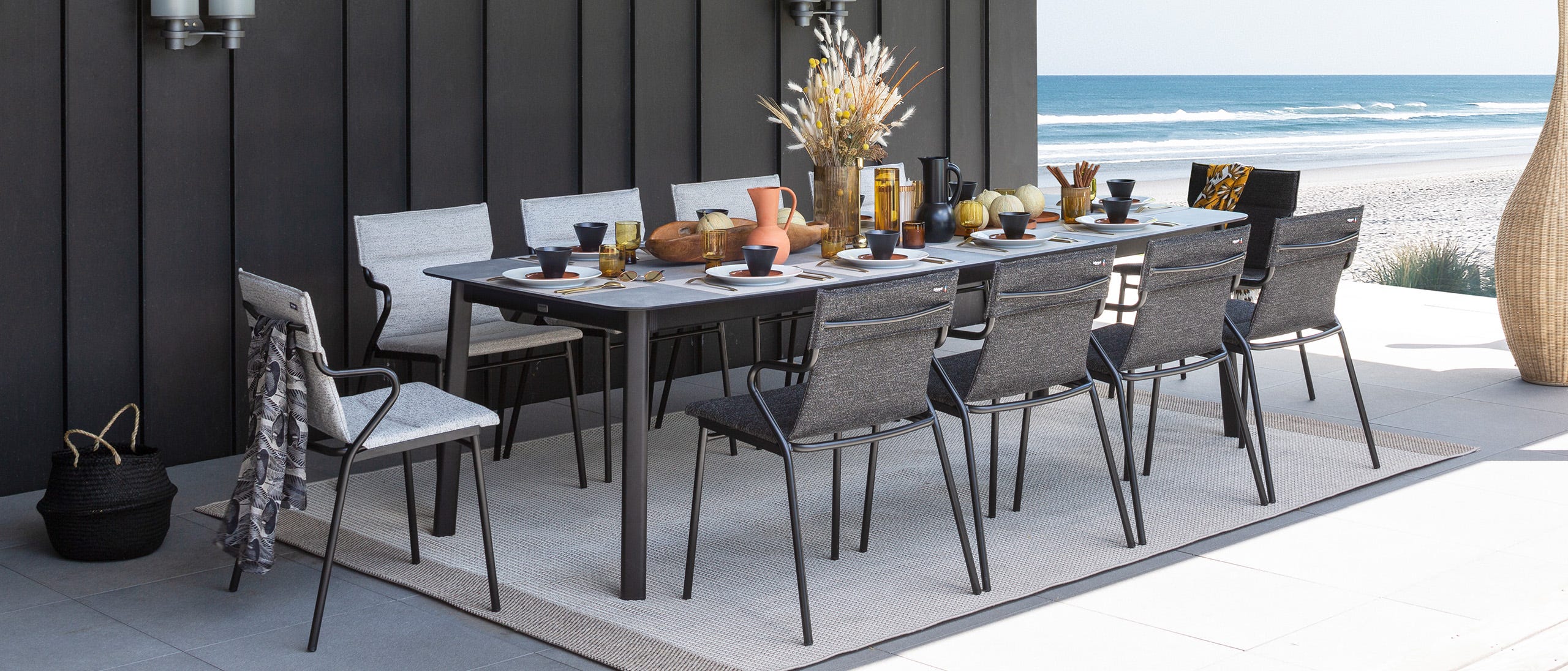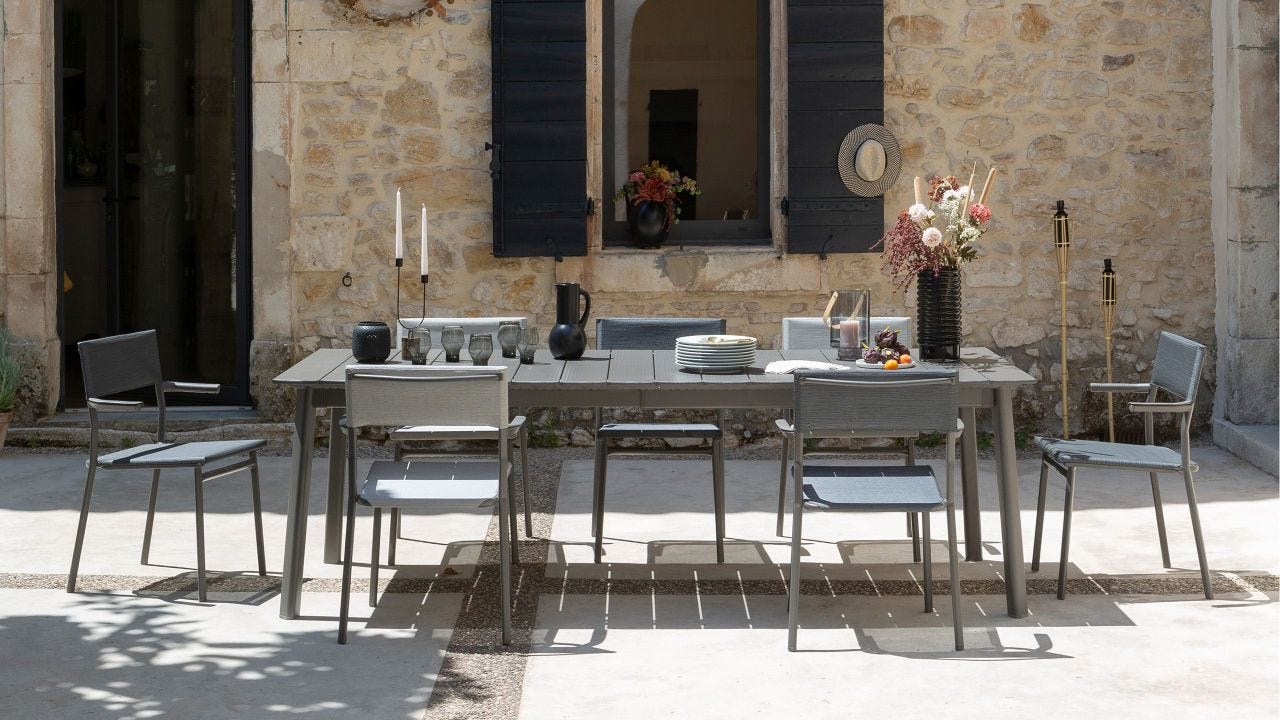🏡📦 Now shipping from our UK warehouse — Fast & Free delivery from £100 😉
When it’s sunny, there’s nothing better than a nice garden table for your morning cup of coffee, weekend family lunch or a BBQ with your friends. But where do you start when choosing the best garden table? Small or large? Round, square or rectangular? Extendable or not? Wood, metal or plastic? If you’re feeling a bit bewildered by all the options and aren’t sure how to decide on the best garden dining table, then read our guide! We’ll show you how to choose the perfect garden table for you.
Choosing the best garden table: ask the right questions
Obviously you’ll choose one that you like the look of. No doubt you will have leafed through countless interior design magazines, pinned ideas on Pinterest and scrolled through countless photos Instagram, so you will already have a rough idea of the ambience you’d like to create in your garden or patio. However, there are other factors to bear in mind for a durable table. When choosing the best garden dining table, you first need to ask the right questions.
Around my garden dining table?
First things first: how many people will you have round to visit on a regular basis? Do you live alone, as a couple or do you have children? You also need to think about your lifestyle. Do you often have friends and family over for dinner? Do you prefer small gatherings or larger events with friends? By pinning down your needs, you’ll have a better idea of which model to opt for.
For a garden table?
The second thing to consider is the space available. Are you looking for a table for a balcony, a patio, conservatory or a large garden? The solution depend on how much space you have available and where you want to put it.


What is the best material for a garden table? Not an easy decision to make.
Wood, metal or plastic? What is the best material for a garden table ? There are a whole host of different materials used for outdoor furniture. Manufacturers are always striving to become more creative than their competitors and are constantly bringing out ever more impressive models, each more inspiring than the last. A garden table is the main focus of a dining area and sets the whole tone and ambience of your garden, whether it be rural, contemporary, industrial or open-air bistro style. But you shouldn’t choose your table solely based on aesthetics. Each material has its pros and cons.
Wooden garden tables
To give your patio a warm and welcoming vibe, nothing beats wood. Wood is a traditional material and a long-standing classic in garden furniture. Wooden garden tables are made from various different species, such as European wood (pine, oak, larch and black locust) and exotic wood (teak, cumaru and itauba). It’s worth noting that choosing a wooden garden table isn’t necessarily the environmentally friendly choice. To be sure that the wood has been sustainably harvested, look out for these two labels: FSC and PEFC. All wood species are ranked on a scale of 1 to 5, depending on how resistant to moisture they are. Whichever species you choose, wood will need to be stained or treated with oil to keep it looking as good as new year after year.
| Pros | Solid Natural look |
| Cons | Needs to be treated |
Metal garden tables
Due to their contemporary vibe, metal garden tables are a resounding success. Being rust-resistant, aluminium tables are completely weatherproof. Another benefit of aluminium is that it’s ultra-lightweight, which is a real bonus if you need to move your garden table around on a regular basis. Conversely, we don’t recommend a fully aluminium table if you live in a windy area, as it can easily be blown over! Steel is heavier than aluminium, but also more robust. It is impact resistant and more windproof. Various different treatments can be applied to steel to increase its resistance to rust and UV rays (galvanised steel, epoxy steel or stainless steel). In addition to these, the paint also plays a critical role, as it can strengthen its resistance to rust and scratches. Wrought iron is even heavier than steel and well-suited to windy areas. However, it needs to be maintained using specific products as it has a tendency to rust. It is worth noting that metal garden furniture gets hot in the sun. Something to bear in mind if your patio isn’t shaded. It might be time to invest in a parasol!
| Aluminium | Steel | Wrought iron | |
| Pros | Rustproof Lightweight No maintenance |
Robust No maintenance |
Very robust |
| Cons | Too lightweight for windy areas Gets hot in the sun |
Gets hot in the sun | Rusts Gets hot in the sun |
Plastic garden tables
Plastic furniture is a designer’s dream, as it lends itself well to a wide range of colours and shapes. It is lightweight, relatively weatherproof and easy to maintain. Different types of plastic can be used for garden tables. While PCV is an inexpensive option, polypropylene, woven resin (similar to rattan) or polyethylene are the high end plastics to consider. If you’re after something more durable, it is best to choose one that has been UV-treated and coloured to keep the colours vibrant over time. It is worth noting that polypropylene is sensitive to frost. For greater resistance, choose injected polypropylene or a composite model with fibreglass.
| Pros | Lightweight Weatherproof Easy to maintain |
| Cons | Depending on the quality, the colours can fade Polypropylene is sensitive to frost |
HPL garden tables
While plastic, metal and wood all have their pros and cons, some manufacturers have considered more durable alternatives. LAFUMA Mobilier is one such manufacturer, turning to a ground-breaking material for our garden tables: HPL or high pressure compact laminate. HPL is a high end material made of 70% recycled kraft paper or wood fibre and 30% thermosetting plastic resin. Although HPL has been used for several years now to manufacture urban style furniture and kitchen worktops, it is less heard of on the interior design scene. However it is undeniably first class. It is a durable material that can last decades. It is also very resistant to heat. HPL tables are simple to maintain, only requiring a sponge, soapy water and a soft cloth. You should avoid using abrasive cleaning products which can scratch. At the end of its life, it can be recycled and repurposed. HPL ticks all the boxes!
| Pros | Durable material (lifespan of 50 years) Weatherproof and resistant to UV rays Impact and abrasion resistant Can withstand high temperatures Easy to maintain |
| Cons | More expensive material |

What size patio table should I get?
Bear in mind that there are two important factors to take into account when choosing your garden table size: the space you have available and the number of people you’ll be hosting.
If you don’t have much space then a folding table that can easily be stored away is a good option. If you choose for a more imposing option, make sure there is enough space for people to move freely around the table. Which table shape is best? This is not only a question of taste. While many people favour round or oval tables as they create a more conversational atmosphere, another benefit is that they can accommodate more people for the same dimensions. Rectangular tables are larger and allow more space for plates and dishes. This makes them perfect for celebrations.
The number of people will also determine the ideal length of your table. What size patio table should I get? Generally speaking, for everyone to be comfortable, you should allow between 55 and 60 cm per person. If you only hold large gatherings every once in a while, you don’t necessarily need too large a table. Opt for an extendable garden table. Depending on whether it is a single or double extending table, they can accommodate between 2 and 4 or additional people. Remember to have an appropriate number of chairs available.
| Number of people | Round table | Square table | Rectangular table |
| 2 people | 60 cm | 60 x 60 cm | 60 x 100 cm |
| 4 people | 90 cm | 100 x 100 cm | 70 x 110 cm |
| 6 people | 120 cm | 120 x 120 cm | 90 x 150 cm |
| 8 people | 130 cm | 150 x 150 cm | 100 x 200 cm |
| 10 people | 150 cm | 160 x 160 cm | 100 x 240 cm |
The advantages of choosing a high quality garden table
Obviously you can expect to pay more for a good quality garden table than a cheaper option. However, as with any purchase, you will see a greater return of investment in the long run. To make an informed decision you will have to consider your personal preference, as well as the factors described above. Below is a summary of what a high quality table should be: stable, solid, weatherproof and UV resistant. It should also be easy to move around, store, clean and maintain.
LAFUMA MOBILIER garden tables compared
| Designed for | Table top dimensions | Folding | Extendable | Table top material | Legs | |
|
BALCONY Table Square |
2 people | 68 x 64 cm | Yes | No | Steel | HLE steel |
| ANYTIME Table Rectangular |
4 people | 68 x 110 cm | Yes | No | HPL | HLE steel |
| ANYTIME Table Rectangular XL |
4/6 people | 79 x 139 cm | Yes | No | HPL | HLE steel |
| ANCÔNE Table Rectangular |
6/8 people | 108 x 220 cm | Yes | No | HPL | Aluminium |
| ANCÔNE Table Rectangular extendable |
8/10 people | 108 x (220 > 280 cm) | No | Yes | HPL | Aluminium |
| ORON S Table Rectangular |
4/6 people | 100 x 154 cm | No | No | HPL or Aluminium | Aluminium |
| ORON M Table Rectangular extendable |
6/8 people | 100 x (169 > 209 cm) HPL 100 x (169 > 214 cm) ALU |
No | Yes | HPL or Aluminium | Aluminium |
| ORON L Table Rectangular extendable |
8/10 people | 100 x (185 > 245 cm) | No | Yes | HPL or Aluminium | Aluminium |
Garden tables Made in France: LAFUMA MOBILIER’s commitment
When it comes to our garden tables, as with all of our outdoor furniture, LAFUMA Mobilier always uses durable materials. Since the beginning, we made the decision to be Made in France, to guarantee our expertise. All of the brand’s products are made in Anneyron, Drôme, a historic industrial site in Balmes, Ain. In addition to promoting local economic development, this local approach means we have been able to reduce our carbon footprint.



































